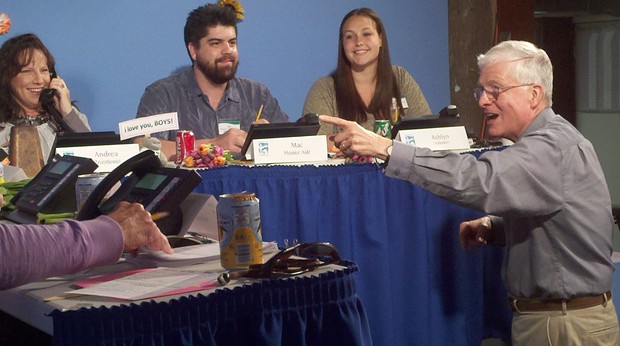KEET at the Crossroads
With a big federal grant at risk, a public television station weighs its options
By J. Daniel Fernandez[
{
"name": "Top Stories Video Pair",
"insertPoint": "7",
"component": "17087298",
"parentWrapperClass": "fdn-ads-inline-content-block",
"requiredCountToDisplay": "1"
}
]
On the outskirts of southern Eureka sits a faded, light-blue building, which — except for the looming broadcast tower and small parking lot — looks like a slightly larger version of the homes that surround it. From here on Humboldt Hill, KEET-TV beams some of our favorite shows to Humboldt County and beyond: Downton Abbey, Antiques Road Show, Sesame Street. Earlier this month, as bursts of cheers and a clanging cow bell erupted inside the station, volunteers were helping it fight for survival.
They had gathered to auction off gift certificates, chocolates and even a Les Paul guitar to raise funds for the local Public Broadcast Service (PBS) affiliate. But while the spring auction happens every year, this one has an especially difficult edge.
Looming over the heads of KEET's 13 employees and numerous volunteers is the prospect of losing a federal grant worth $540,000, one-third of the station's $1.6 million operating budget.
The 2013 fiscal year for KEET ends this month, and with the start of the 2014 fiscal year beginning on July 1, the station still does not have a final budget in place.
Nor will it know its fate until mid-September, when the board of directors of the Corporation for Public Broadcasting — the entity charged with distributing public television funds allocated by Congress — meets again to make a decision on that $540,000 grant.
Without the grant, KEET would have to cut from several pools including employee health benefits and funding for local productions like Original Patriots, a documentary about local Native American veterans who served in World War II. Even the right to broadcast PBS programing is potentially on the chopping block. However, KEET will not make a comment about specific plans until after the public broadcasting corporation board meets.
At issue is whether KEET can remain viable over the long term.
Last October, the corporation sent KEET a letter telling the station that it could lose the $540,000 Television Community Service Grant because it wasn't raising enough non-federal money to qualify.
In order for a public broadcast station to qualify for that grant, it must raise an average of at least $800,000 annually in non-federal financial support over three consecutive years. That non-federal support can come from a wide range of sources: memberships, underwriting from businesses and individuals, auctions and other fundraisers, state or local grants, donations, bequests and special gifts like stocks or cash.
KEET has never raised $800,000 in its 44 years of broadcasting, according to its Executive Director, Ron Schoenherr. Documents provided by KEET show that from all those sources, from 2009 to 2011, KEET raised less than $600,000 annually. The closest it came to reaching the goal was last year when Charles Kehoe of Brookings, Ore., died and left the station his investment portfolio, worth just under $200,000. That brought KEET's non-federal support up to $770,000 for fiscal year 2012.
Mark Erstling, a senior vice president for the Corporation for Public Broadcasting, says KEET's budget is out of sync with the original intent of the Public Broadcasting Act of 1967. "We're looking at long-term sustainability. Federal grants were never intended to be a major source of funding," he said in a telephone interview. "Our interest is not exactly in preserving the current station. It's to get PBS to the public."
In its letter last fall, the corporation gave KEET until June 30 to show that, "it has significantly improved its long-term financial sustainability through a merger, consolidation, or collaboration."
Schoenherr has ruled out the possibility of a merger or consolidation, saying that he has focused instead on collaboration.
KEET approached stations in Sacramento and San Francisco about collaborating, but they declined due to distance and financial concerns. KEET eventually found a partner in KIXE, the public broadcasting affiliate in Redding.
In April, KEET's board of directors passed a resolution to collaborate with KIXE and in turn, KIXE's board approved the collaboration by passing its own resolution in May. The move "may save both of us," Shoenherr said. That's because KIXE is currently going through its own fight to get approval for federal funding. KIXE fell short of the $800,000 minimum by $13,000. That was the first time it has failed to do so since its start in 1964, said KIXE station director Mike Lampella.
In the past, KEET could bypass the minimum requirement by applying for a waiver based on its rural location and limited resources, but that changed in 2010.
As Erstling explained in a follow up email to the Journal, the corporation board made the change based on recommendations from a panel of consultants. "The panel recommended that a weak station barely surviving was ultimately not good for the system, and that CPB should intervene to help stations in this situation consider their options, including, but not limited to, collaborations."
Collaboration can come in the form of producing a documentary together or by eliminating redundant departments such as payroll and fundraising. The goal is to show proof of financial stability in order to qualify for federal funding.
However, Erstling acknowledged that collaboration will not help stations reach the $800,000 goal. Each station must raise that much on its own. Still, Erstling wrote in his email, "The right collaboration can yield not only savings to a station's operations by aggregating costs, but also by consolidating best practices in fundraising and other functional areas that smaller markets sometimes find more difficult to attract and retain."
Schoenherr is among the public television advocates who have called, without success, for the minimum requirement to be lowered for smaller rural stations. "How many Fortune 500 companies are in Humboldt?" Schoenherr asked. "Those large markets can raise what they need in a few days." According to Schoenherr, Humboldt County residents already contribute about $6 per capita, more than six times the national average of 90 cents.
Culturally, the loss of funding to KEET would be a blow to all of Humboldt County, says Ross Rowley, who makes his living producing commercials here, but values the independence that public broadcasting gets from not having to rely on commercial sponsors. Rowley has volunteered at KEET-TV for 34 years and was helping out at the recent auction. "When KEET produces a program about local Native veterans who served in World War II, or about the meth problems in Humboldt, the community gets an identity," he said. "It's a reflection of the community that you don't get from a station outside of the area."
Another auction volunteer, The Emerald magazine founder Christina De Giovanni, says KEET's community spirit really shows in programs like its HomeWork Hotline show, from 4:30 to 5 p.m. on Tuesdays and Thursdays. "Kids who didn't get enough help in class can get it during the show," she said. "That's a really good service."
But in the end, it comes down to economics. As Erstling wrote, "The economics of public television stations are rapidly changing, and the operating models that worked for the past 40 and 50 years don't necessarily sustain a station's financial viability."
Comments
Showing 1-1 of 1
more from the author
-
35 Days in the Forum
Unified Students' sit-in shines a light on Native issues at HSU
- Feb 26, 2015
-
Bakers, Mustard Makers Break Free
Cottage food bill opens up sales from home kitchens
- Nov 14, 2013
-
Straightening the Hairpins
Highway 299 remake will create a smoother, faster ride — eventually
- Jul 11, 2013
- More »
Latest in News
Readers also liked…
-
Through Mark Larson's Lens
A local photographer's favorite images of 2022 in Humboldt
- Jan 5, 2023
-
'To Celebrate Our Sovereignty'
Yurok Tribe to host gathering honoring 'ultimate river warrior' on the anniversary of the U.S. Supreme Court ruling that changed everything
- Jun 8, 2023

































